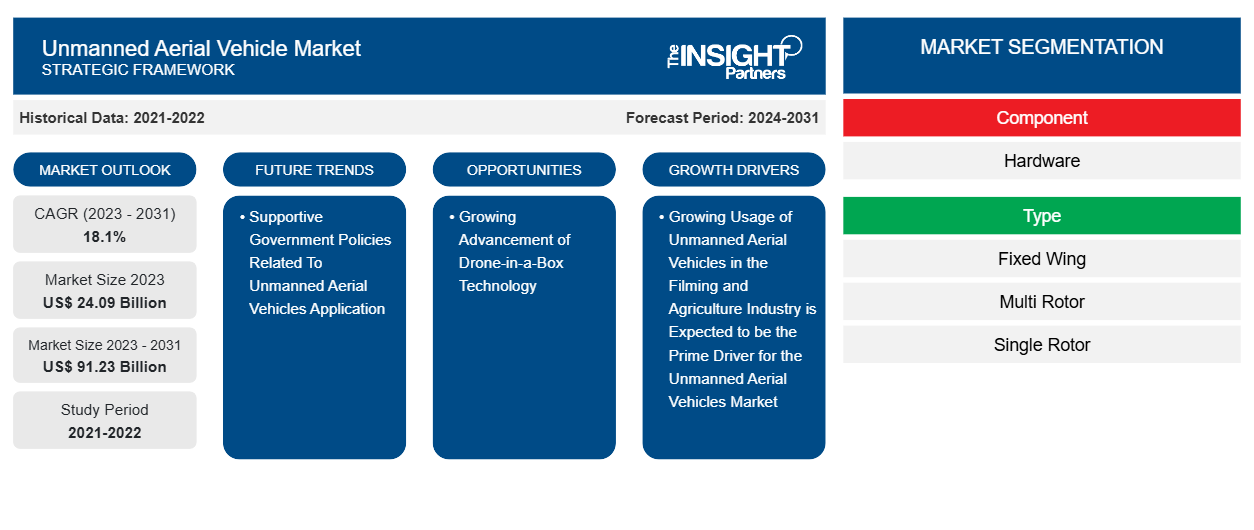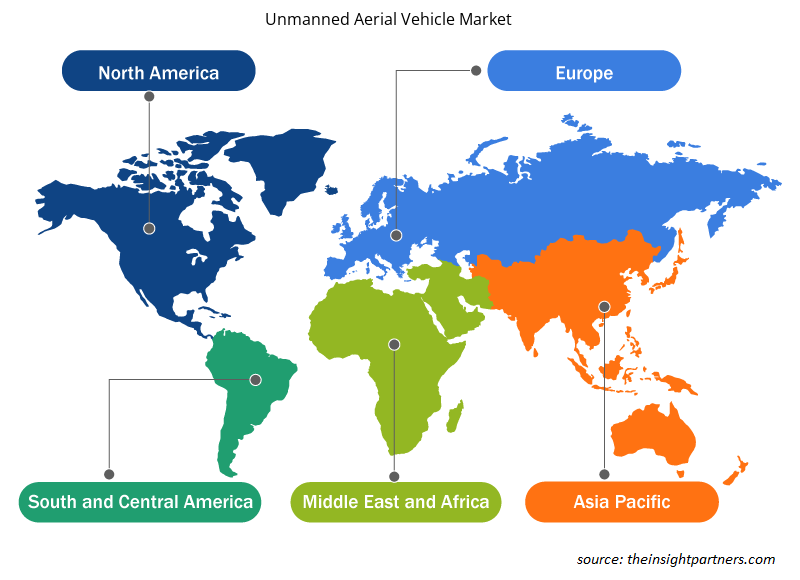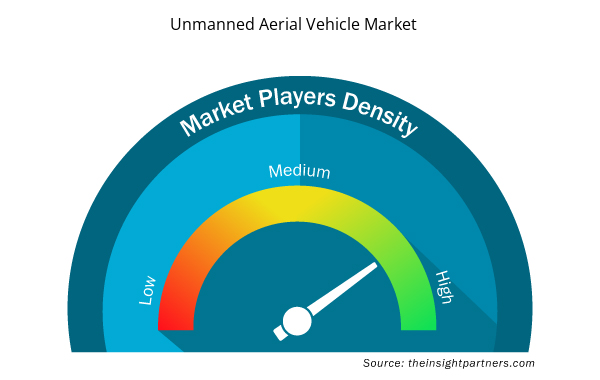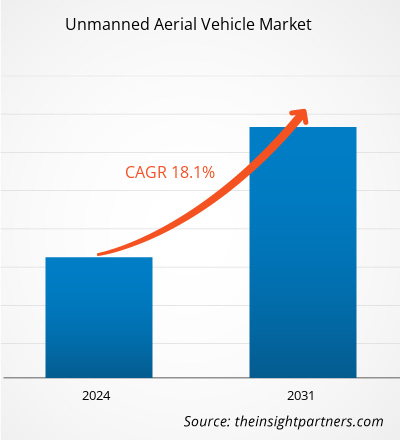The Unmanned Aerial Vehicle Market size is projected to reach US$ 91.23 billion by 2031 from US$ 24.09 billion in 2023. The market is expected to register a CAGR of 18.1% in 2023–2031. The growing proliferation of unmanned aerial vehicles for precision farming, photography, and surveillance purposes is driving the growth of the unmanned aerial vehicles market globally.
Unmanned Aerial Vehicle Market Analysis
Increasing application of unmanned aerial vehicles in various end use industries such as agriculture, oil & gas, and mining are anticipated to drive the growth of the unmanned aerial vehicle market at the global level. Increasing penetration of unmanned aerial vehicles in the defense and security sector for capturing aerial images to enhance the measures for strong defense systems is anticipated to boost the development of the unmanned aerial vehicle market worldwide. Additionally, the rising application of unmanned aerial vehicles for mapping and surveying, emergency search, response, rescue tasks, maritime rescue, and meteorology, among others, is driving the advancement of the unmanned aerial vehicle market globally. AI-driven aspects such as autonomous flight, object tracking, and automated image processing improved the unmanned aerial vehicles capabilities and aided new applications, which is having a positive impact on the unmanned aerial vehicle Market.
Unmanned Aerial Vehicle Market Overview
The growing proliferation of unmanned aerial vehicles for monitoring any casualty situation such as flood, earthquake, or fire outbreak is also acting as a major driver for the market. The rescue operators primarily leverage drones for surveillance and monitoring purposes and to get an aerial view of the overall situation, which helps in making major decisions regarding the ways to initiate rescue operations. Additionally, the rising application of unmanned aerial vehicles in the oil & gas and mining exploration sector is also having a positive impact on the unmanned aerial vehicle market globally. The unmanned aerial vehicle market is segmented by component, type, and application. In terms of component, the unmanned aerial vehicle market is categorized into hardware (camera, sensors, and others) and software. On the basis of type, the market is classified into fixed wing, multi rotor, single rotor, and hybrid. In addition, on the basis of application, the market is segmented into retail, military & defense, media & entertainment, personal, agriculture, industrial, law enforcement, and construction.
Customize This Report To Suit Your Requirement
You will get customization on any report - free of charge - including parts of this report, or country-level analysis, Excel Data pack, as well as avail great offers and discounts for start-ups & universities
Unmanned Aerial Vehicle Market: Strategic Insights

- Get Top Key Market Trends of this report.This FREE sample will include data analysis, ranging from market trends to estimates and forecasts.
You will get customization on any report - free of charge - including parts of this report, or country-level analysis, Excel Data pack, as well as avail great offers and discounts for start-ups & universities
Unmanned Aerial Vehicle Market: Strategic Insights

- Get Top Key Market Trends of this report.This FREE sample will include data analysis, ranging from market trends to estimates and forecasts.
Unmanned Aerial Vehicle Market Drivers and Opportunities
Growing Usage of Unmanned Aerial Vehicles in the Filming and Agriculture Industry is Expected to be the Prime Driver for the Unmanned Aerial Vehicles Market
The growing demand for unmanned aerial vehicles for filming aerial shots and videography in the media and entertainment industry is one of the major drivers for the unmanned aerial vehicle market. The rising application of high-end drone cameras for capturing wide-angle aerial videos and images is also improving the growth of the unmanned aerial vehicle market at the global level. The growing proliferation of digitalization and integration of software applications to monitor the overall operational efficiency of farming land is anticipated to drive the growth of the unmanned aerial vehicle market globally. The real-time data and aerial images of the complete farm help the farmers identify the issues concerning the land’s well-being, which might negatively impact the crop production rate. Additionally, managing mid to large-size agricultural lands in remote locations is unmanageable if UAV cameras are not in application, as they help in capturing aerial images of the land for better operational management. Thus, the utilization of advanced technologies is appearing as a major driving factor for the market.
Supportive Government Policies Related to Unmanned Aerial Vehicles Application
Supportive government policies for flying drones help in agriculture land management, same-day package delivery, filming and photography, and monitoring and capturing images of oil and gas and mining sites. Thus, the rising governmental support and assistance for using advanced unmanned aerial vehicles for surveillance, monitoring, and security is anticipated to increase the development of the unmanned aerial vehicle market in coming years. The rising geopolitical disturbances and growing war-like situations are propelling the application of unmanned aerial vehicle cameras for surveillance purposes, which is anticipated to propel the evolution of the market over the forecast period.
Unmanned Aerial Vehicle Market Report Segmentation Analysis
Key segments that contributed to the derivation of the unmanned aerial vehicle market analysis are component, type, and application.
- Based on component, the unmanned aerial vehicle market has been divided into hardware (camera, sensors, and others) and software. The hardware segment held a larger market share in 2023.
- In terms of type, the market has been segmented into fixed wing, multi rotor, single rotor, and hybrid. The hybrid segments dominated the market in 2023.
- In terms of application, the market has been segmented into military & defense, retail, media & entertainment, personal, agriculture, industrial, law enforcement, and construction. The military & defense segments dominated the market in 2023.
Unmanned Aerial Vehicle Market Share Analysis by Geography
The geographic scope of the Unmanned Aerial Vehicle Market report is mainly divided into five regions: North America, Europe, Asia Pacific, Middle East & Africa, and South America.
North America led the unmanned aerial vehicle market in 2023. The North America region includes the US, Canada, and Mexico. Many companies across the region are focusing on investing in advanced unmanned aerial vehicles to meet modern filming, photography, agricultural, construction, defense, and security requirements. Thus, the growing application of unmanned aerial vehicles to augment precision farming, along with increasing demand for high-end unmanned aerial vehicles for films and photography, is estimated to drive the development of the market over the forecast period in North America. Surveying and capturing high-end images and monitoring and identifying security challenges are also some of the major application areas of unmanned aerial vehicles in the North America region, which helps in defense security and process streamlining in the oil & gas and mining sectors. An increasing number of mining and oil & gas exploration and production activities are boosting the demand for unmanned aerial vehicles for sensing, monitoring, and capturing aerial images of the sites for augmenting better operation management, which is also having a positive influence on the unmanned aerial vehicle market in North America.
Unmanned Aerial Vehicle Market Regional Insights
The regional trends and factors influencing the Unmanned Aerial Vehicle Market throughout the forecast period have been thoroughly explained by the analysts at Insight Partners. This section also discusses Unmanned Aerial Vehicle Market segments and geography across North America, Europe, Asia Pacific, Middle East and Africa, and South and Central America.

- Get the Regional Specific Data for Unmanned Aerial Vehicle Market
Unmanned Aerial Vehicle Market Report Scope
| Report Attribute | Details |
|---|---|
| Market size in 2023 | US$ 24.09 Billion |
| Market Size by 2031 | US$ 91.23 Billion |
| Global CAGR (2023 - 2031) | 18.1% |
| Historical Data | 2021-2022 |
| Forecast period | 2024-2031 |
| Segments Covered |
By Component
|
| Regions and Countries Covered | North America
|
| Market leaders and key company profiles |
Unmanned Aerial Vehicle Market Players Density: Understanding Its Impact on Business Dynamics
The Unmanned Aerial Vehicle Market is growing rapidly, driven by increasing end-user demand due to factors such as evolving consumer preferences, technological advancements, and greater awareness of the product's benefits. As demand rises, businesses are expanding their offerings, innovating to meet consumer needs, and capitalizing on emerging trends, which further fuels market growth.
Market players density refers to the distribution of firms or companies operating within a particular market or industry. It indicates how many competitors (market players) are present in a given market space relative to its size or total market value.
Major Companies operating in the Unmanned Aerial Vehicle Market are:
- DJI
- Parrot SA
- 3D Robotics Inc
- Yuneec International Co Ltd
- Airware
- AeroVironment Inc
Disclaimer: The companies listed above are not ranked in any particular order.

- Get the Unmanned Aerial Vehicle Market top key players overview
Unmanned Aerial Vehicle Market News and Recent Developments
The Unmanned Aerial Vehicle Market is evaluated by gathering qualitative and quantitative data post primary and secondary research, which includes important corporate publications, association data, and databases. The following is a list of developments in the market for Unmanned Aerial Vehicle Market and strategies:
- On April 2024, DJI launched the Agras T50 and Agras T25 drones. (Source: DJI, Press Release/Company Website/Newsletter)
- On April 2024, the Swedish Defence Materiel Administration procured UAV 06 Skatan from Parrot SA for its Home Guard military reserve unit. (Source: Parrot SA, Press Release/Company Website/Newsletter)
Unmanned Aerial Vehicle Market Report Coverage and Deliverables
The “Unmanned Aerial Vehicle Market Size and Forecast (2021–2031)” report provides a detailed analysis of the market covering below areas:
- Market size and forecast at global, regional, and country levels for all the key market segments covered under the scope
- Market dynamics such as drivers, restraints, and key opportunities
- Key future trends
- Detailed PEST analysis
- Global and regional market analysis covering key market trends, major players, regulations, and recent market developments
- Industry landscape and competition analysis covering market concentration, heat map analysis, prominent players, and recent developments
- Detailed company profiles with SWOT analysis
- Historical Analysis (2 Years), Base Year, Forecast (7 Years) with CAGR
- PEST and SWOT Analysis
- Market Size Value / Volume - Global, Regional, Country
- Industry and Competitive Landscape
- Excel Dataset


- Influenza Vaccines Market
- Long Read Sequencing Market
- Resistance Bands Market
- Industrial Valves Market
- 3D Mapping and Modelling Market
- Integrated Platform Management System Market
- Embolization Devices Market
- Drain Cleaning Equipment Market
- Enzymatic DNA Synthesis Market
- Print Management Software Market

Report Coverage
Revenue forecast, Company Analysis, Industry landscape, Growth factors, and Trends

Segment Covered
Component, Type, Application, and Geography

Regional Scope
North America, Europe, Asia Pacific, Middle East & Africa, South & Central America

Country Scope
This text is related
to country scope.

 Get Free Sample For
Get Free Sample For